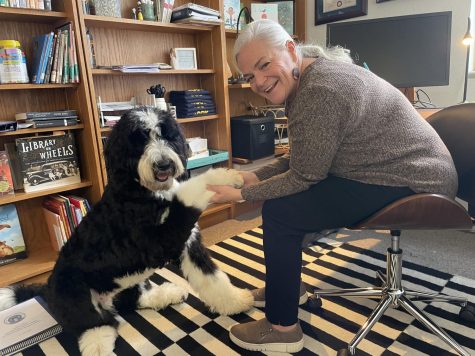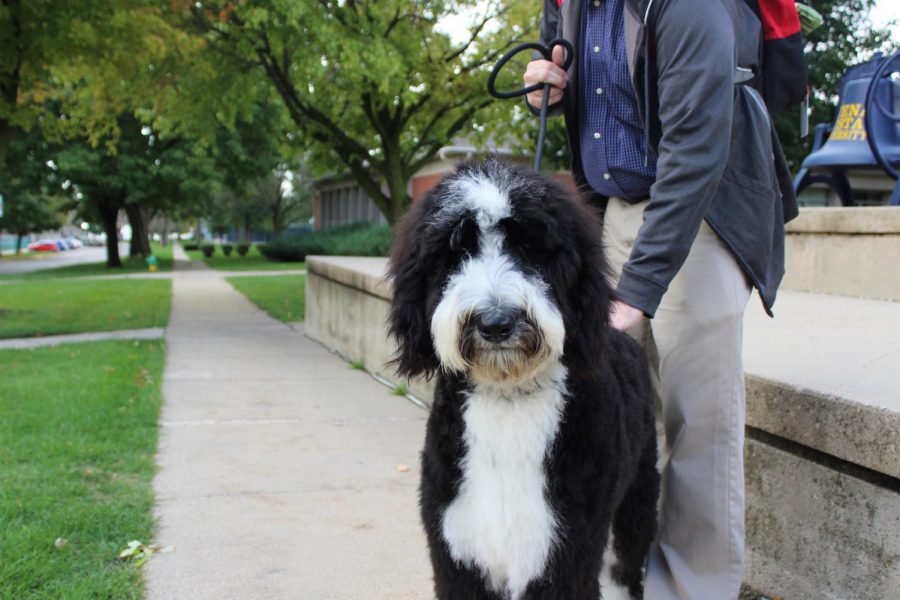Pawsitive Mental Health
November 5, 2021

Buena Vista University’s counseling services got an interesting helping hand this year — one without hands, but in fact paws.
Calle Friesen, BVU’s Associate Professor of Education, Literacy, and Early Childhood Education, has started bringing her dog Cooper to campus. Cooper, Friesen’s sheepadoodle, is on campus every Wednesday, and is a certified therapy dog. “One thing we have talked about is how important it is to clarify Cooper’s role,” she says. “A therapy dog is a little bit different, as Cooper is a working dog. They have to have specialized training. ESA, therapy dog, service dog — all three are different.” She puts on her therapy dog backpack and grabs Cooper’s leash, stating, “I have to make it obvious he’s a therapy dog. I’m like his billboard.”

Cooper is not an emotional support animal. ESAs and certified therapy dogs are completely different. While any animal can be registered as an ESA, therapy dogs are raised to go into work someday; to be dramatic, one could say Cooper was plucked at birth for his job. “Therapy dogs are selected for their disposition. Even as little, little puppies, a good candidate is a middle-of-the-pack pup; not aggressive, not interested in being an alpha, but also not a pushover, because in their work, they have to take initiative, so they have to be middle-ground.” Therapy dogs undergo submission tests, disposition exams, and are constantly being evaluated. “Certain breeds make better working dogs than others. You need a dog that is very trainable and pleasant to touch. Because the therapy requires touch, “the touch is the greatest benefit for the human,” she explains.
Cooper is a sheepadoodle, so he’s one of the best, Friesen explains. “Poodles are very smart, and sheep dogs are very loyal, so when you put those two together, potentially, you have a dog who is very smart and loyal and responds well to training.” ‘Ideal training,’ as Friesen uses, is how Cooper became Cooper. “We found a really good training facility in South Dakota where we sent him away for boarding training for six weeks. They work on a lot of stuff, obedience training and then I get trained as his primary handler.”

Julie Anderson, Head of Counseling Services, says, “Animals have demonstrated decreases in depression symptoms, particuarly in the area of isolation. I think having another live being that’s social and give you a sense of connection is great.” Friesen agrees, saying “There is something about being in close contact with another heart beat — it is a living, breathing soul that is warm, and as you interact with a dog, a lot of things happen. Your heart rate decreases, your anxiety decreases. Some people even say that you start to get in sync with each other.” Sounds magical; some would even say therapeutic.
On occasion, Cooper can be seen walking around campus with Friesen or with a therapist from counseling services. He will greet students with energy and love. Students can go on a walk with Cooper each Wednesday from noon to 1:00 (if not weather permitting, then through academic buildings and the Forum), and visit him in the relaxation room in Dixon-Eilers from 1:00 to 2:00. He occasionally stops by classrooms and therapy sessions as well.









